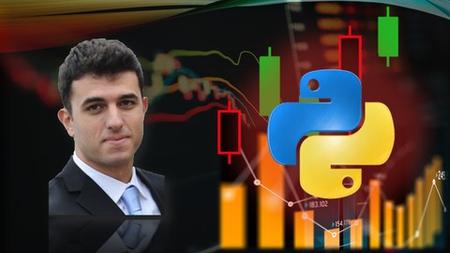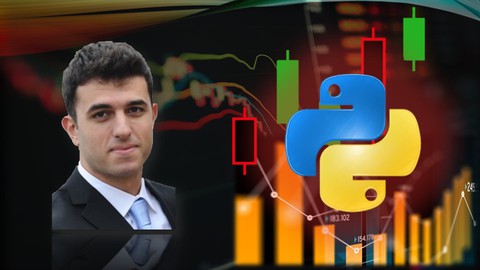Algorithmic Trading Strategies In Python
Published 10/2023
MP4 | Video: h264, 1920x1080 | Audio: AAC, 44.1 KHz
Language: English | Size: 4.27 GB | Duration: 6h 46m
Published 10/2023
MP4 | Video: h264, 1920x1080 | Audio: AAC, 44.1 KHz
Language: English | Size: 4.27 GB | Duration: 6h 46m
Master Algorithmic Trading: Unlock Profitable Strategies And Backtesting Using Python
What you'll learn
Understand the main essential components of a trading strategy
Design a targeted trading system
Implement and backtest a trading system in Python
Code algorithmic trading strategies in Python
Backtest and evaluate an automated trading system
Requirements
Python basics familiarity, Pandas and Numpy, basic understanding of Object Oriented Programming in Python
Trading familiarity and simple strategies
Description
Welcome to the comprehensive course on Algorithmic Trading Strategies in Python! Join me, Ziad, a seasoned algorithmic trader with over a decade of experience, as I guide you through the fascinating world of algorithmic trading.In this course, we delve into the fundamentals of algorithmic trading, covering essential concepts, trading mindsets, and the pros and cons of algorithmic trading. Gain a deep understanding of trading terminology, explore technical versus fundamental trading, and grasp basic trading strategies that form the foundation of algorithmic trading.Discover various types of algorithmic trading strategies, including Mean Reversion, Momentum Trading, and Statistical Arbitrage. Learn how to retrieve and analyze market data using Python, exploring timeframes, ticks data, and utilizing APIs for data retrieval. Dive into the implementation of technical analysis with Python libraries such as TA-Lib and Pandas_TA for effective technical indicators analysis.Explore advanced topics in statistical analysis and modeling, including Time Series Analysis, Statistical Arbitrage, and Factor Models. Develop and optimize your trading strategies, understanding the main components critical for success. Put your strategies to the test through backtesting, evaluating performance, and ensuring robust results.Finally, master the execution of trades using Python, transitioning seamlessly from backtesting to live trading. This course is designed to be straight to the point, focusing on numerical trading systems in Python. While some Python background is assumed, if you need to strengthen your skills, I offer separate courses covering Python basics, object-oriented programming, and in-depth training on Numpy and Pandas.Whether you're a seasoned developer or just starting your coding journey, this course provides valuable insights, practical knowledge, and a clear roadmap to mastering algorithmic trading in Python. Take the next step in your trading journey and enroll now!Key Topics:Algorithmic Trading BasicsTrading Mindset and EmotionsTechnical and Fundamental TradingMean Reversion, Momentum, Statistical Arbitrage StrategiesData Retrieval and Exploratory Analysis in PythonTechnical Indicators with TA-Lib and Pandas_TAStatistical Analysis and ModelingStrategy Development and OptimizationBacktesting for Performance EvaluationExecution and Live Trading with PythonUnlock the power of algorithmic trading today! Enroll and transform your trading strategies with Python expertise.
Overview
Section 1: Course Introduciton
Lecture 1 Introduction
Lecture 2 About This Course
Lecture 3 Course Content
Section 2: Introduction To Algorithmic Trading
Lecture 4 Introduction To Algorithmic Trading
Lecture 5 Emotions and Biases
Lecture 6 A Trading Mindset
Lecture 7 Why To Use Algorithms?
Lecture 8 Emotions In Trading
Lecture 9 Defining Algorithmic Trading
Lecture 10 Revisiting Emotions And Real Life Case
Lecture 11 Overview: Types Of Simple Algorithmic Strategies
Lecture 12 Python Programming As A Prerequisite
Section 3: Trading Concepts
Lecture 13 Technical Vs Fundamental Algorithms
Lecture 14 Bid and Ask Spread and Volume as Market Liquidity Indicators
Lecture 15 Types of Financial Markets
Lecture 16 Market Participants and Big Market Players
Lecture 17 Basic Types of Algorithmic Trading Strategies
Section 4: Financial Data Retrieval And Exploratory Analysis
Lecture 18 Knowing Data Types
Lecture 19 Types Of Financial Data
Lecture 20 Downloading Historical Data For Analysis
Lecture 21 Candlesticks and Indicators Plotting Example
Lecture 22 Additional Visualization Tutorial
Section 5: Technical Indicators Analysis
Lecture 23 Technical Indicators Introduction
Lecture 24 Trend Indicators
Lecture 25 Moving Average And ADX Indicators
Lecture 26 Moving Average And ADX Python Example
Lecture 27 Momentum Indicators : The RSI
Lecture 28 Momentum Indicators : Stochastic Oscillator
Lecture 29 Momentum Indicators Python Examples
Lecture 30 Volatility Indicators: Bollinger Bands
Lecture 31 Volatility Indicators: Average True Range
Lecture 32 Volatility Indicators: Python Examples
Lecture 33 Volume Indicators
Lecture 34 Volume Indicators: CMF
Lecture 35 Volume Indicators: Python Examples
Section 6: Testing Technical Indicators
Lecture 36 Technical Testing Methods I
Lecture 37 Technical Testing Methods II
Lecture 38 Testing Rejection Candle Indicator
Section 7: Building Algorithmic Trading Systems
Lecture 39 Algorithmic Strategy Components
Lecture 40 Trend Detection And Confirmation
Lecture 41 Generating Entry Signals
Lecture 42 Exit Signal Approaches
Lecture 43 Lot Size And Dynamic Sizing
Lecture 44 Python Application: Trend Detection Using The Moving Average Slope
Lecture 45 Python Application: Trend Detection Using 3 Moving Averages Alignment
Lecture 46 Python Application: Consecutive Candles Positions Vs The Moving Average
Lecture 47 Python Application: VWAP And Candles Positions
Lecture 48 Python Application: Trend Confirmation With The ADX
Lecture 49 Python Application: Entry Signal Detection I (Bollinger Bands)
Lecture 50 Python Application: Entry Signal Detection II (Bollinger Bands With RSI)
Lecture 51 Python Application: Entry Signal Detection III (Bollinger Bands With Rejection)
Section 8: Backtesting Trading Strategies
Lecture 52 Backtesting Introduction
Lecture 53 Backtesting Tools And Python Packages
Lecture 54 Backtesting Dot Py Package Python Examples
Lecture 55 Quality Ratios And Backtest Evaluation
Section 9: Python Profitable Strategy Example Step-By-Step
Lecture 56 Strategy Introduction
Lecture 57 Strategy Details: Technical Description
Lecture 58 Detecting Rejection Candles And Support Resistance Levels
Lecture 59 Combining Rejection And Key Levels Signals
Lecture 60 Generating Automated Entry Signal
Lecture 61 Backtest Results: Fixed Stop Loss And Take Profit Values
Lecture 62 Backtest Results: RSI Exit Signal
Lecture 63 Backtest Results: ATR Dependent SL and TP Values
Lecture 64 Backtest Results: Trailing Stop In Python
Lecture 65 Backtest Results: Lot Sizing And Returns Optimization
Section 10: Live Trading Bot: Putting It All Together
Lecture 66 Live Trading Example In Python
Traders, and beginner and intermediate Python developers,Enthusiasts willing to explore the field of financial programming and algorithmic trading



